Simultaneous Second-Harmonic, Sum-Frequency Generation and Stimulated Raman Scattering in MgO:PPLN
Abstract
:1. Introduction
2. Experimental Configuration
3. Results and Discussion
4. Conclusions
Author Contributions
Funding
Acknowledgments
Conflicts of Interest
References
- Johansson, S.; Spiekermann, S.; Wang, S.; Pasiskevicius, V.; Laurell, F.; Ekvall, K. Generation of Turquoise Light by Sum Frequency Mixing of a Diode-Pumped Solid-State Laser and a Laser Diode in Periodically Poled KTP. Opt. Express 2004, 12, 4935–4940. [Google Scholar] [CrossRef] [PubMed]
- Pennacchietti, F.; Serebrovskaya, E.O.; Faro, A.R.; Shemyakina, I.I.; Bozhanova, N.G.; Kotlobay, A.A.; Gurskaya, N.G.; Bodén, A.; Dreier, J.; Chudakov, D.M.; et al. Fast Reversibly Photoswitching Red Fluorescent Proteins for Live-Cell RESOLFT Nanoscopy. Nat. Methods 2018, 15, 601–604. [Google Scholar] [CrossRef] [PubMed]
- Kapoor, V.; Subach, F.V.; Kozlov, V.G.; Grudinin, A.; Verkhusha, V.V.; Telford, W.G. New Lasers for Flow Cytometry: Filling the Gaps. Nat. Methods 2007, 4, 678–679. [Google Scholar] [CrossRef] [PubMed]
- Xu, Z.Y.; Bi, Y. Large Laser Projection Displays Utilizing All-Solid-State RGB Lasers. In Light-Emitting Diode Materials and Devices, Proceedings of the Photonics Asia, Beijing, China, 8–11 November 2004; SPIE Proceedings; John Wiley & Sons Ltd.: Oboken, NJ, USA, 2005; Volume 5632, pp. 115–122. [Google Scholar]
- Mizuuchi, K.; Yamamoto, K.; Kato, M. Harmonic Blue Light Generation in X-Cut MgO:LiNbO3 Waveguide. Electron. Lett. 1997, 33, 806–807. [Google Scholar] [CrossRef]
- Bostani, A.; Tehranchi, A.; Kashyap, R. Super-Tunable, Broadband up-Conversion of a High-Power CW Laser in an Engineered Nonlinear Crystal. Sci. Rep. 2017, 7, 883. [Google Scholar] [CrossRef] [PubMed]
- Li, G.; Choge, D.; Chen, H.; Xu, Y.; Guo, L.; Liang, W. Broadband and Triple-Wavelength Continuous Wave Orange Laser by Single-Pass Sum-Frequency Generation in Step-Chirped MgO:PPLN. Appl. Sci. 2018, 8, 1657. [Google Scholar] [CrossRef]
- Mieth, S.; Henderson, A.; Halfmann, T. Tunable, Continuous-Wave Optical Parametric Oscillator with More than 1 W Output Power in the Orange Visible Spectrum. Opt. Express 2014, 22, 11182–11191. [Google Scholar] [CrossRef] [PubMed]
- Bisson, S.E.; Armstrong, K.M.; Kulp, T.J.; Hartings, M. Broadly Tunable, Mode-Hop-Tuned cw Optical Parametric Oscillator Based on Periodically Poled Lithium Niobate. Appl. Opt. 2001, 40, 6049–6055. [Google Scholar] [CrossRef] [PubMed]
- Imeshev, G.; Proctor, M.; Fejer, M.M. Phase Correction in Double-Pass Quasi-Phase-Matched Second-Harmonic Generation with a Wedged Crystal. Opt. Lett. 1998, 23, 165–167. [Google Scholar] [CrossRef] [PubMed]
- Okishev, A.V.; Zuegel, J.D. Intracavity-Pumped Raman Laser Action in a Mid-IR, Continuous-Wave (cw) MgO:PPLN Optical Parametric Oscillator. Opt. Express 2006, 14, 12169–12173. [Google Scholar] [CrossRef] [PubMed]
- My, T.-H.; Robin, O.; Mhibik, O.; Drag, C.; Bretenaker, F. Stimulated Raman Scattering in an Optical Parametric Oscillator Based on Periodically Poled MgO-Doped Stoichiometric LiTaO3. Opt. Express 2009, 17, 5912–5918. [Google Scholar] [CrossRef] [PubMed]
- Zverev, P.G.; Basiev, T.T.; Prokhorov, A.M. Stimulated Raman Scattering of Laser Radiation in Raman Crystals. Opt. Mater. 1999, 11, 335–352. [Google Scholar] [CrossRef]
- Johnston, W.D.J.; Kaminow, I.P. Temperature Dependence of Raman and Rayleigh Scattering in LiNbO3 and LiTaO3. Phys. Rev. 1968, 168, 1045–1054. [Google Scholar] [CrossRef]
- Barker, A.S.; Loudon, R. Dielectric Properties and Optical Phonons in LiNbO3. Phys. Rev. 1967, 158, 433–445. [Google Scholar] [CrossRef]
- Schaufele, R.F.; Weber, M.J. Raman Scattering by Lithium Niobate. Phys. Rev. 1966, 152, 705–708. [Google Scholar] [CrossRef]
- McConnell, G.; Ferguson, A. Simultaneous Stimulated Raman Scattering and Second Harmonic Generation in Periodically Poled Lithium Niobate. Opt. Express 2005, 13, 2099–2104. [Google Scholar] [CrossRef] [PubMed]
- Pasiskevicius, V.; Canalias, C.; Laurell, F. Highly Efficient Stimulated Raman Scattering of Picosecond Pulses in KTiOPO4. Appl. Phys. Lett. 2006, 88, 041110. [Google Scholar] [CrossRef]
- Choge, D.K.; Chen, H.; Xu, Y.; Guo, L.; Li, G. Blue and Orange Two-Color CW Laser Based on Single-Pass Second-Harmonic and Sum-Frequency Generation in MgO:PPLN. Appl. Sci. 2018, 8, 629. [Google Scholar] [CrossRef]
- Chen, B.Q.; Ren, M.L.; Liu, R.J.; Zhang, C.; Sheng, Y.; Ma, B.Q.; Li, Z.Y. Simultaneous Broadband Generation of Second and Third Harmonics from Chirped Nonlinear Photonic Crystals. Light Sci. Appl. 2014, 3, e189. [Google Scholar] [CrossRef]
- Yarborough, J.M.; Falk, J.; Hitz, C.B. Enhancement of Optical Second Harmonic Generation by Utilizing the Dispersion of Air. Appl. Phys. Lett. 1971, 18, 70–73. [Google Scholar] [CrossRef]
- Sanna, S.; Neufeld, S.; Rüsing, M.; Berth, G.; Zrenner, A.; Schmidt, W.G. Raman Scattering Efficiency in LiTaO3 and LiNbO3 Crystals. Phys. Rev. B 2015, 91, 224302. [Google Scholar] [CrossRef]
- Henderson, A.; Stafford, R. Spectral Broadening and Stimulated Raman Conversion in a Continuous-Wave Optical Parametric Oscillator. Opt. Lett. 2007, 32, 1281–1283. [Google Scholar] [CrossRef] [PubMed]
- Powers, P.E. Field Guide to Nonlinear Optics; Greivenkamp, J.E., Ed.; SPIE: Bellingham, WA, USA, 2013. [Google Scholar]
- Dang, W.; Chen, Y.; Gong, M.; Chen, X. Competition between SFG and Two SHGs in Broadband Type-I QPM. Appl. Phys. B Lasers Opt. 2013, 110, 477–482. [Google Scholar] [CrossRef]
- Mehendale, S.C.; Forysiak, W.; Cheng, C.; Harrison, R.G. Influence of Competition on Optical Sum Frequency Generation. Opt. Commun. 1986, 59, 304–308. [Google Scholar] [CrossRef]
- Pasiskevicius, V.; Fragemann, A.; Laurell, F.; Butkus, R.; Smilgevicius, V.; Piskarskas, A. Enhanced Stimulated Raman Scattering in Optical Parametric Oscillators from Periodically Poled KTiOPO4. Appl. Phys. Lett. 2003, 82, 325–327. [Google Scholar] [CrossRef]
- Iwai, M.; Yoshino, T.; Yamaguchi, S.; Imaeda, M.; Pavel, N.; Shoji, I.; Taira, T. High-Power Blue Generation from a Periodically Poled MgO:LiNbO3 Ridge-Type Waveguide by Frequency Doubling of a Diode End-Pumped Nd:Y3Al5O12 Laser. Appl. Phys. Lett. 2003, 83, 3659–3661. [Google Scholar] [CrossRef]
- Gayer, O.; Sacks, Z.; Galun, E.; Arie, A. Temperature and Wavelength Dependent Refractive Index Equations for MgO-Doped Congruent and Stoichiometric LiNbO3. Appl. Phys. B Lasers Opt. 2008, 91, 343–348. [Google Scholar] [CrossRef]
- Hum, D.S.; Fejer, M.M. Quasi-Phasematching. C. R. Phys. 2007, 8, 180–198. [Google Scholar] [CrossRef]
- Fejer, M.M.; Magel, G.A.; Jundt, D.H.; Byer, R.L. Quasi-Phase-Matched Second Harmonic Generation: Tuning and Tolerances. IEEE J. Quantum Electron. 1992, 28, 2631–2654. [Google Scholar] [CrossRef]
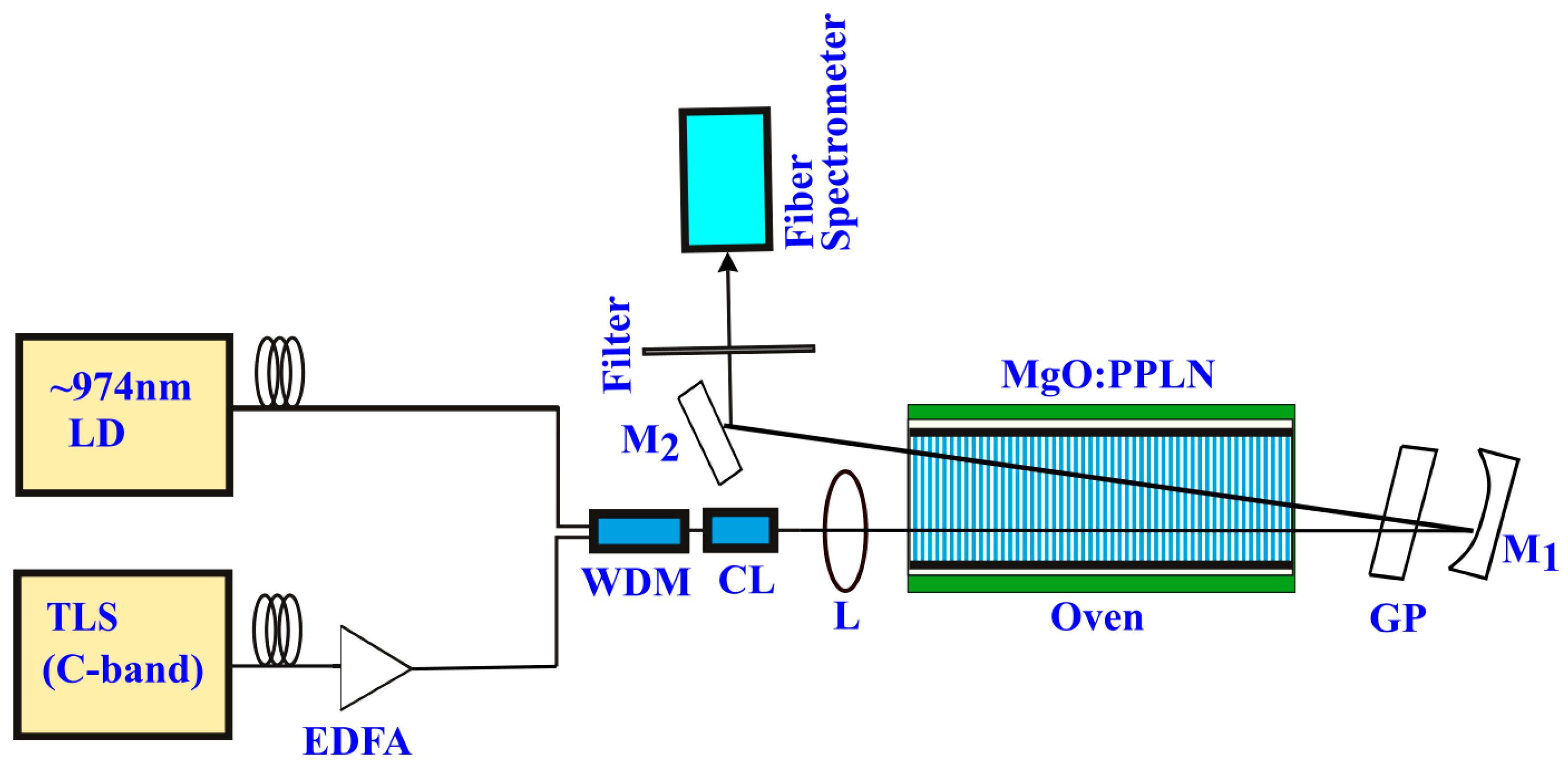
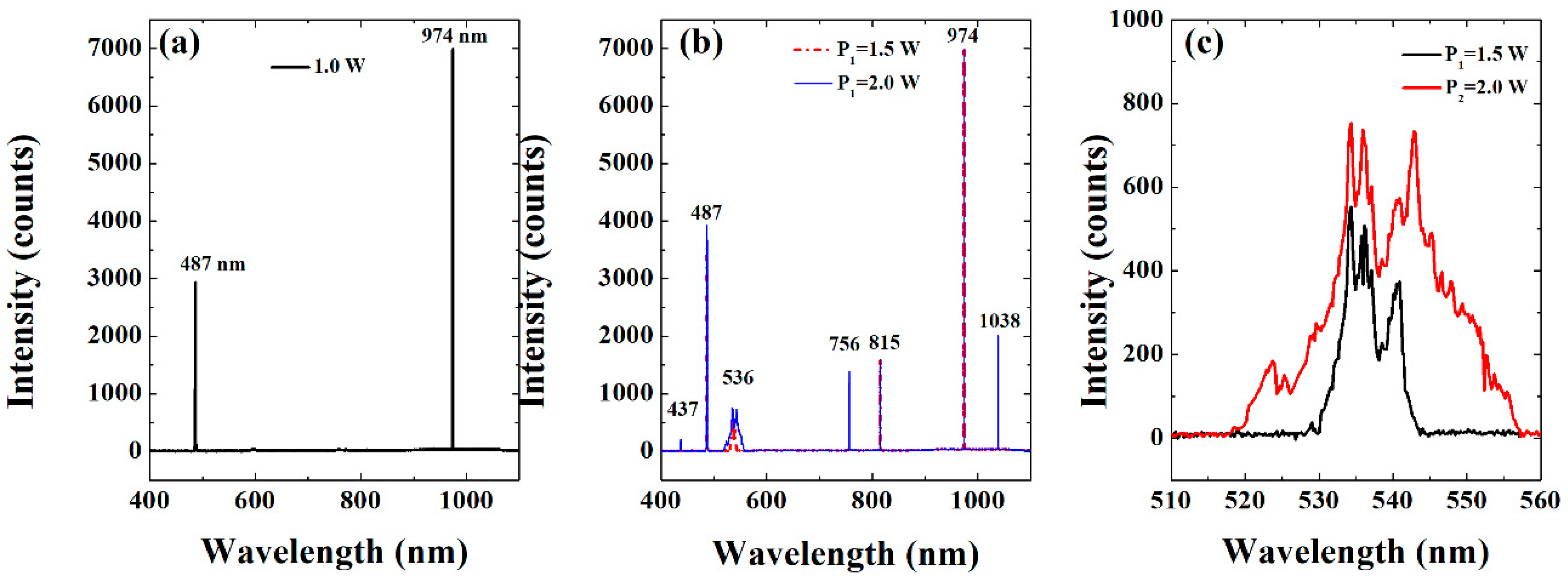
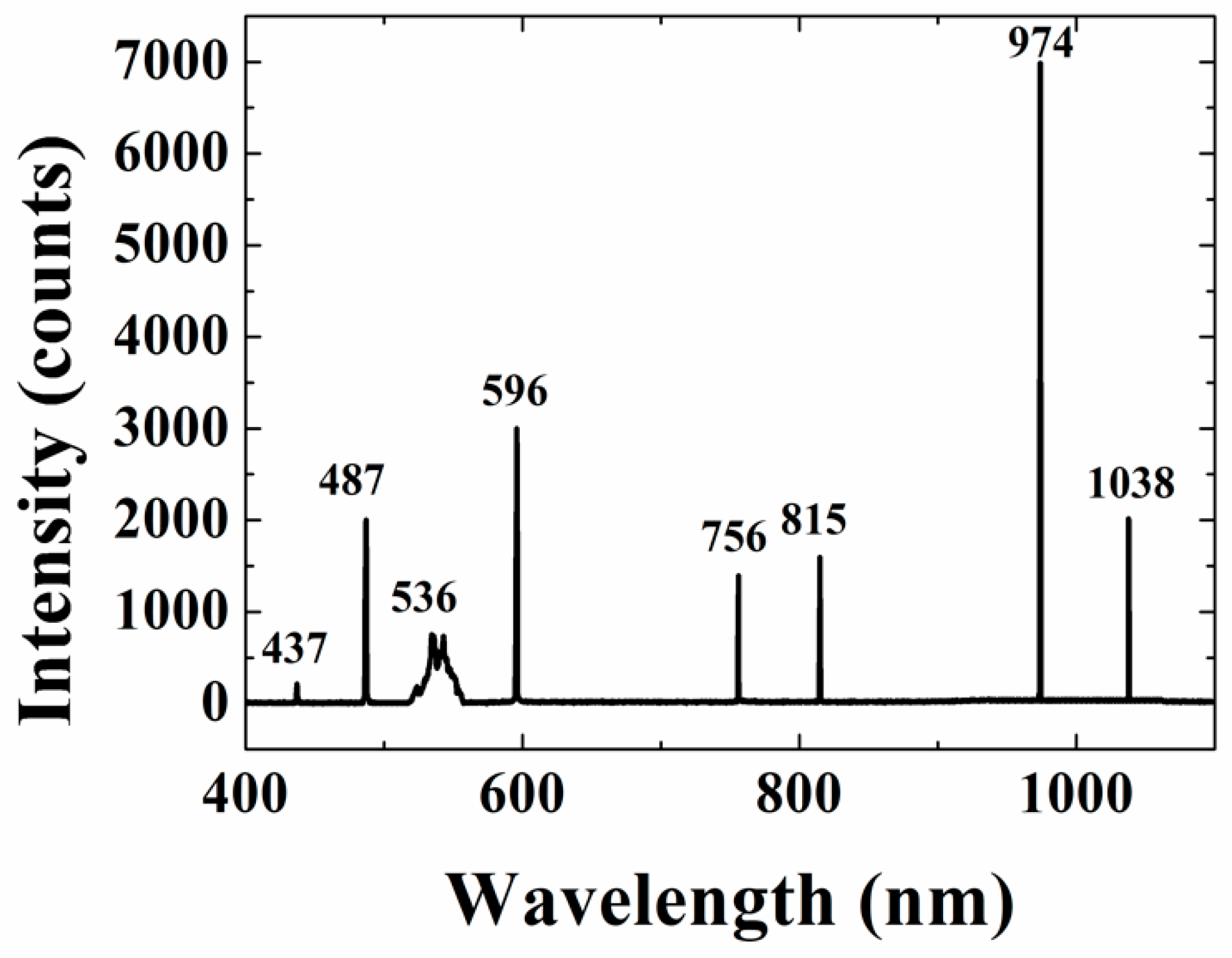
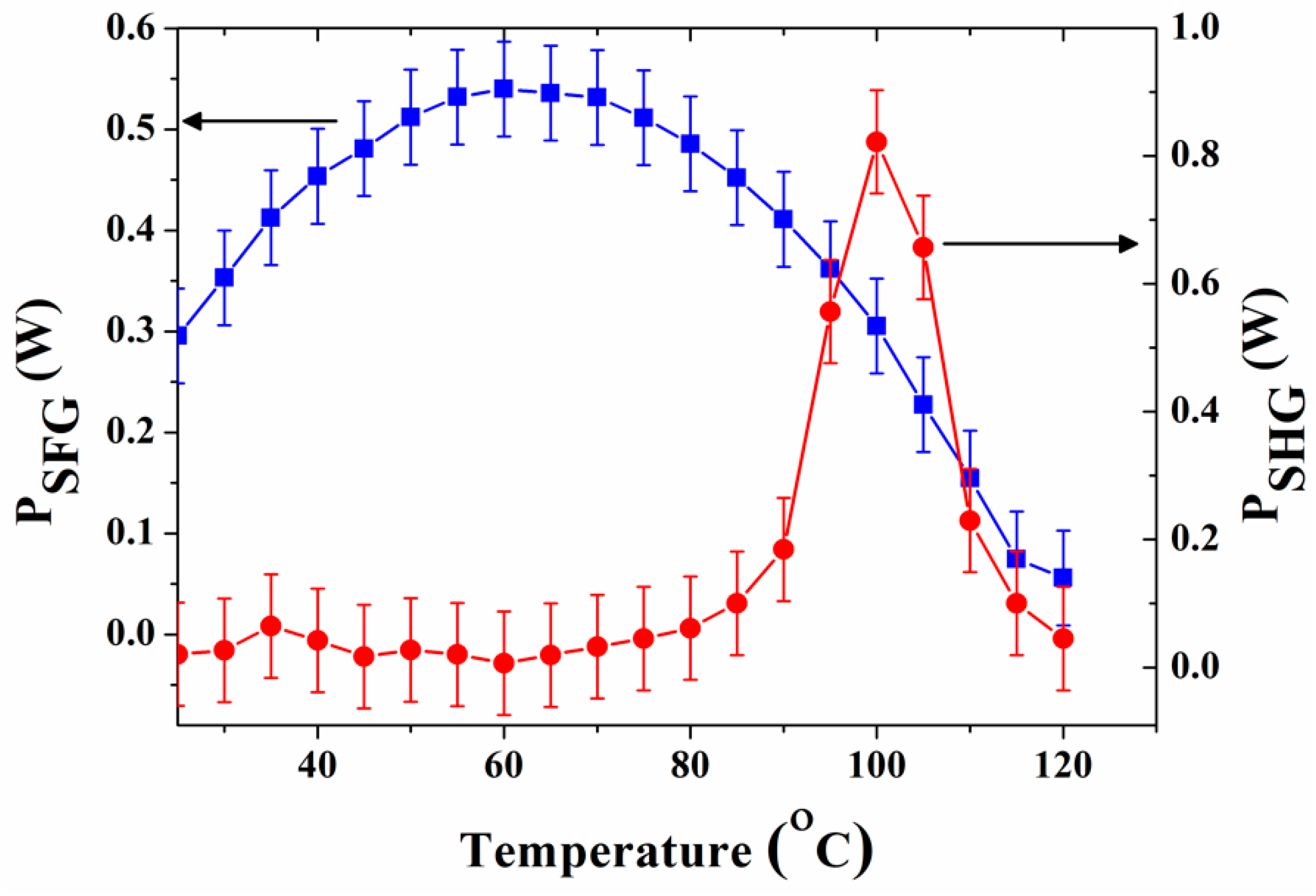
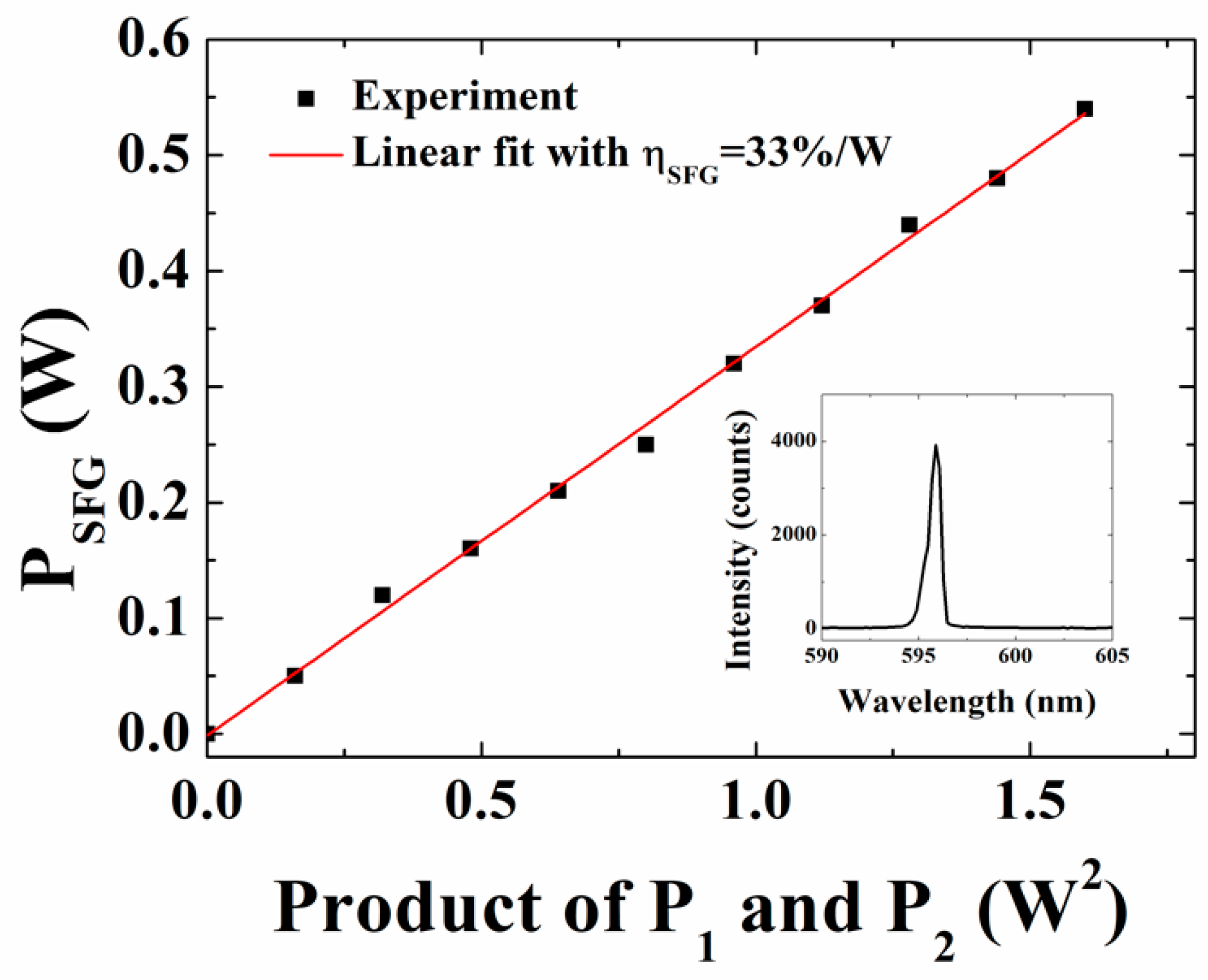
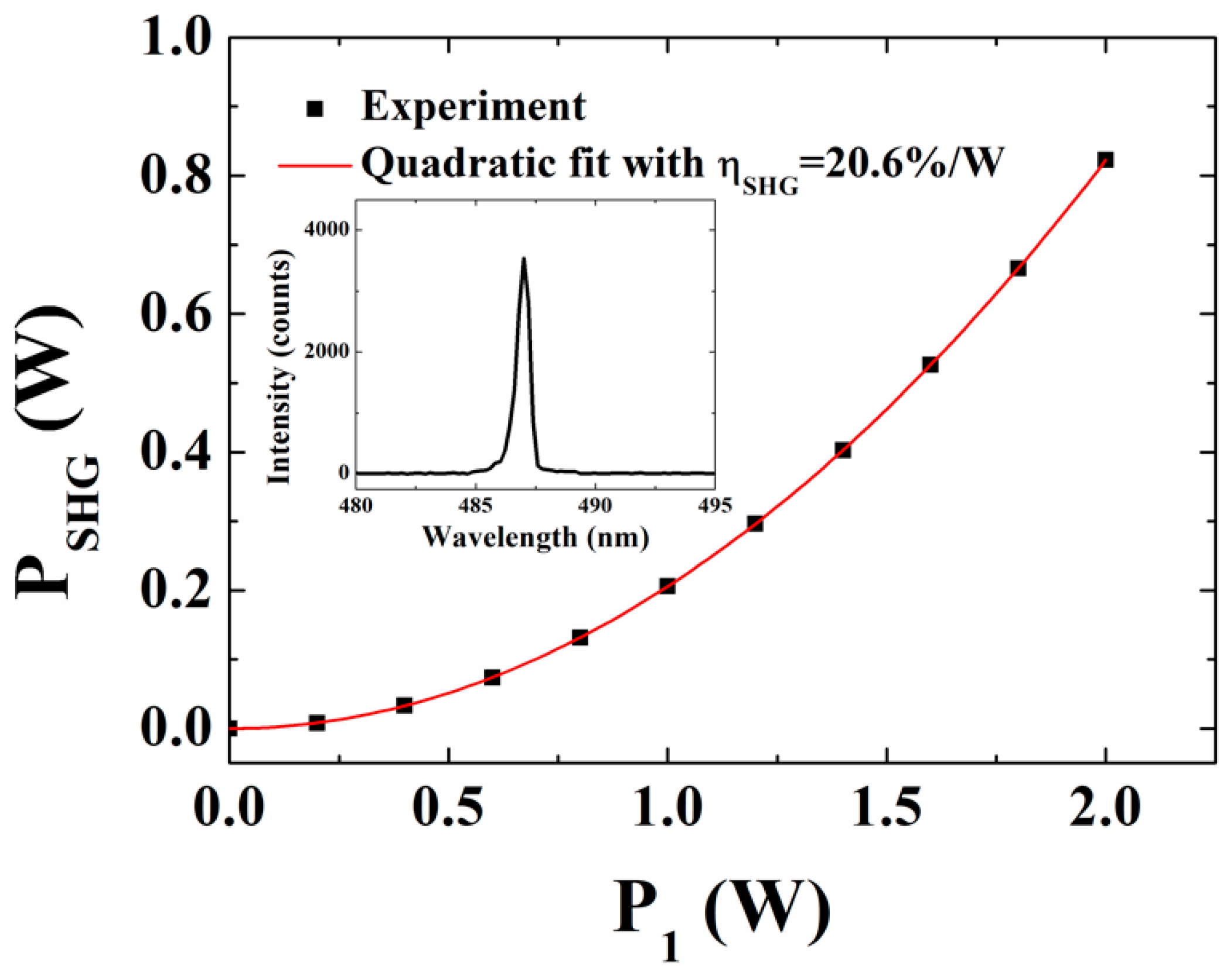
© 2018 by the authors. Licensee MDPI, Basel, Switzerland. This article is an open access article distributed under the terms and conditions of the Creative Commons Attribution (CC BY) license (http://creativecommons.org/licenses/by/4.0/).
Share and Cite
Choge, D.K.; Chen, H.; Guo, L.; Li, G.; Liang, W. Simultaneous Second-Harmonic, Sum-Frequency Generation and Stimulated Raman Scattering in MgO:PPLN. Materials 2018, 11, 2266. https://doi.org/10.3390/ma11112266
Choge DK, Chen H, Guo L, Li G, Liang W. Simultaneous Second-Harmonic, Sum-Frequency Generation and Stimulated Raman Scattering in MgO:PPLN. Materials. 2018; 11(11):2266. https://doi.org/10.3390/ma11112266
Chicago/Turabian StyleChoge, Dismas K., Huaixi Chen, Lei Guo, Guangwei Li, and Wanguo Liang. 2018. "Simultaneous Second-Harmonic, Sum-Frequency Generation and Stimulated Raman Scattering in MgO:PPLN" Materials 11, no. 11: 2266. https://doi.org/10.3390/ma11112266




